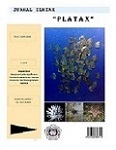The inventory of macroalgae in the Mantehage Island waters, Wori sub-district, North Minahasa district in North Sulawesi Province
DOI:
https://doi.org/10.35800/jip.4.2.2016.14077Abstract
This study was carried out in Mantehage Island waters, covering Bango, Tinongko, Buhias, and Tangkasi, with an objective of knowing the taxa composition of macroalgae through morphological studies. Data collection used  Line Transect method with quadrat. Three 100 m-transect line were placed perpendicular to the coastline. Distance between transects was 50 m, and the quadrat used was 1 x 1 m².
Results found 44 species of microalgae, consisting of 3 divisions, 3 classes, 10 orders, 18 families, and 26 genera. Green algae comprised 3 orders, 6 families, 11 genera, and 23 species. Brown algae consisted of 3 orders, 3 families, 5 genera, and 5 species. Red algae had 4 orders, 8 families, 10 genera and 16 species.
Keyword : Macroalga, species, Mantehage Island.
Abstrak
Penelitian ini dilakukan di pulau Mantehage, yakni Desa Bango, Tinongko, Buhias, dan Desa Tangkasi,  dengan tujuan untuk mengetahui komposisi taksa makroalga melalui pendekatan morfologi. Pengambilan data dilakukan dengan menggunakan metode Line Transect kuadrat. Tiga garis transek sepanjang 100 m diletakkan tegak lurus garis pantai dengan jarak antar transek 50 m dan jarak antar kuadrat 10 m. Ukuran kuadrat yang dipakai adalah 1 x 1 m².
Hasil penelitian menemukan 44 spesies, yang terdiri dari 3 divisi, 3 kelas, 10 ordo, 18 famili dan 26 genera. Alga hijau terdiri atas 3 ordo, 6 famili, 11 genera dan 23 spesies. Alga cokelat terdiri atas 3 ordo, 3 famili, 5 genera dan 5 spesies. Adapun alga merah terdiri atas 4 ordo, 8 famili, 10 genera dan 16 spesies.
Kata Kunci : makroalga, species, Pulau Mantehage
Â
2Staf pengajar Fakultas Perikanan dan Ilmu Kelautan Universitas Sam Ratulangi
Downloads
Published
How to Cite
Issue
Section
License
COPYRIGHT
Authors who publish with this journal agree to the following terms:
Authors hold their copyright and grant this journal the privilege of first publication, with the work simultaneously licensed under a Creative Commons Attribution License that permits others to impart the work with an acknowledgment of the work's origin and initial publication by this journal.
Authors can enter into separate or additional contractual arrangements for the non-exclusive distribution of the journal's published version of the work (for example, post it to an institutional repository or publish it in a book), with an acknowledgment of its underlying publication in this journal.
Authors are permitted and encouraged to post their work online (for example, in institutional repositories or on their website) as it can lead to productive exchanges, as well as earlier and greater citation of the published work (See The Effect of Open Access).






































